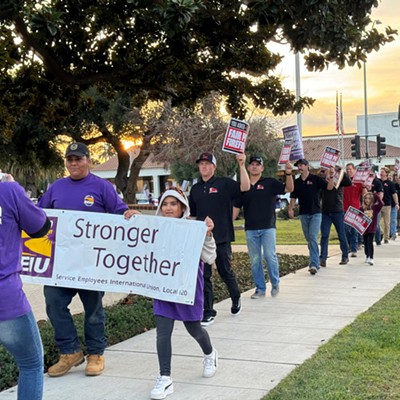For people living with addiction, being isolated during the COVID-19 pandemic is especially difficult. But that’s the reality many have faced over the last two months.

Since the virus began to spread throughout the U.S., and once Gov. Gavin Newsom issued his statewide stay-at-home order in March, the agencies that provide substance abuse treatment programs in Santa Barbara County shifted to meeting and speaking with clients virtually.
Luis Gonzalez, the Lompoc site supervisor for Coast Valley Substance Abuse Treatment Center, said this switch has led to at least one positive outcome—clients seem to open up more over the phone compared to in-person sessions. But this transition has also presented challenges, such as connecting with clients who have limited access to the internet or engaging clients who are just beginning their treatment, he said.
“During this we’ve seen more people dropping out of programs,” Gonzalez said. “They need the structure of face-to-face and stability. Now that is all taken away from them.”
During the Santa Barbara County Board of Supervisors meeting on May 12, Alice Gleghorn, the director of the county’s Department of Behavioral Wellness, told the board that the number of people calling the department’s resource and referral line to be connected with substance abuse treatment programs decreased from 541 in March to 264 in April. Meanwhile, the number of people calling the line for mental health assistance remained about the same.
When somebody calls this referral line, the department then connects them with services through a treatment provider, such as Coast Valley Substance Treatment Center or the Council on Alcoholism and Drug Abuse, among others in the county.
Gleghorn told the board that the department believes part of this drop in people seeking substance abuse treatment is due to the temporary suspension of in-person services. She said some people may not have a private space for telehealth services. Additionally, she said that providers have told her department that there are some clients with more complex situations where it’s difficult to maintain engagement virtually.
“We’re going to need to figure out how we can better serve that population because telehealth is not going to be as successful,” Gleghorn said.
Chuck Madson, treatment system manager at the Council on Alcoholism and Drug Abuse, said after the stay-at-home order went into effect, the agency connected with its more than 200 clients to see what they needed to be able to participate in treatment virtually. This includes helping people learn how to use Zoom or connecting people with services offering free Wi-Fi.
Many of the people working at the Council on Alcoholism and Drug Abuse, including Madson, are in recovery themselves and knew right away that this transition to virtual treatment would be difficult for clients. While there are contributing factors for this, the isolation that clients are forced into is the hardest part, Madson said.
“When we use, we in some ways separate ourselves from the people we care about and the community because we’re active in our addiction,” Madson said. “Living in this situation, I could see it brings back those feelings of isolation for those entering the 12-step program.”
A significant part of treatment, Madson said, is connecting with other people who are going through the same situation. Not being able to celebrate recovery milestones or birthdays in person as a group changes the experience. That’s why he is expecting to see an increase of people seeking treatment after the stay-at-home order is lifted and people can again meet in person.
“I think the biggest thing that’s changed, and the most difficult, for our clients is the fact that they don’t get to walk through a door and experience the first day of asking for help,” Madson said. “That’s something that those in recovery are always thankful for—walking into a place that’s welcoming for the first time. They’re not getting that today.”
Despite referrals being down, Madson said the agency hasn’t experienced an abnormal increase in the number of people dropping out of treatment programs and that most people are continuing their treatment without a problem. However, the transition has been difficult for certain clients.
The roughly 50 youths the agency serves have to balance their virtual treatment with completing schoolwork online. To encourage them to continue participating, Madson said the agency started an incentive-based program where it provides its younger clients with gift cards or composition books for journaling.
Students completing their schoolwork at home also presents a challenge to their parents who may need their family’s only computer in the house to participate in a video call for their own treatment. Gonzalez said in these situations, the center is working with those clients to set up individual and group sessions that work with their schedule.
The necessity for virtual meetings presents a greater challenge for clients experiencing homelessness, such as those who are living in the Santa Ynez riverbed outside of Lompoc. Gonzalez said with so many public spaces closed where these clients normally visit to charge their phones, some clients can’t engage in treatment simply because their cellphone battery runs out.
With these barriers and structural changes in treatment, Gonzalez said he’s heard from some clients that they’ve gone back to using, while others expressed an increased desire to use, but haven’t done so.
“Some of the more secure clients say, ‘If I wasn’t so strong in treatment, this would be a time to use,’” Gonzalez said.
Despite these challenges, Madson and Gonzalez said their agencies were able to make swift transitions to virtual treatment programs while continuing to connect with clients on a daily basis to ensure they have all the resources they need to continue with their recovery.
Whether the clients need help accessing food, child care, housing, or whatever it may be, Madson said the agency continues to serve those needs.
“Everything, overnight, went to a virtual world, and we wanted to make sure we were accommodating that from day one,” Madson said.
Reach Staff Writer Zac Ezzone at [email protected].










